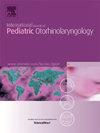Comparative efficacy of intranasal mometasone furoate monotherapy or combination therapy with montelukast in pediatric adenoid hypertrophy: A systematic review and meta-analysis of randomized clinical trials
IF 1.2
4区 医学
Q3 OTORHINOLARYNGOLOGY
International journal of pediatric otorhinolaryngology
Pub Date : 2025-03-17
DOI:10.1016/j.ijporl.2025.112310
引用次数: 0
Abstract
Purpose
Adenoid hypertrophy (AH) is a prevalent pediatric condition associated with nasal obstruction, sleep-disordered breathing, and related comorbidities. This study evaluated comparative efficacies of Mometasone Furoate (MF) monotherapy and MF-Montelukast combination therapy in pediatric AH.
Methods
PubMed, Cochrane Central Register of Controlled Trials, ClinicalTrials.gov, Web of Science, Google Scholar, and Ovid MEDLINE were searched from their inception to August 22, 2024, and five randomized clinical trials (RCTs) with pediatric patients (age <15 years, n = 416) with clinically diagnosed AH, managed with MF monotherapy or MF–montelukast combination therapy, were identified. Outcomes included changes in x-ray adenoids/nasopharynx ratio, endoscopic adenoid obstruction, total symptom score, and individualized symptoms scores of nasal obstruction, rhinorrhea, mouth breathing, and snoring. Although safety data, including neuropsychiatric adverse effects of montelukast, were of interest, they were not reported in the included studies.
Results
Compared to MF-monotherapy, MF–montelukast combination therapy significantly improved (mean difference [95 % confidence interval], p-value) adenoids/nasopharynx ratio (−7.01 [−8.96 to −5.07], <0.001), total symptom score (−1.05 [−1.51 to −0.59], <0.001), rhinorrhea (−0.92 [−1.50 to −0.34], 0.002), mouth breathing (−0.67 [−1.27 to −0.08], 0.02), and endoscopic Grade 4 adenoid obstruction (relative risk 0.25 [0.07–0.84], 0.03); no intergroup differences were noted in nasal obstruction (−0.06 [−0.26 to 0.14], 0.56), snoring (−0.56 [−1.19 to 0.08], 0.08), and endoscopic Grade 3 adenoid obstruction (relative risk 0.70 [0.45–1.09], 0.11).
Conclusion
MF–montelukast combination therapy is superior to MF monotherapy in reducing AH symptoms. However, Montelukast has an FDA black box warning due to potential neuropsychiatric side effects, including suicidal thoughts, depression and behavioral changes. None of the included studies systematically assessed these adverse effects highlighting a critical gap in safety evaluation. High-quality RCT-based research is required to evaluate long-term efficacy, safety, dosage, and cost-effectiveness.
求助全文
约1分钟内获得全文
求助全文
来源期刊
CiteScore
3.20
自引率
6.70%
发文量
276
审稿时长
62 days
期刊介绍:
The purpose of the International Journal of Pediatric Otorhinolaryngology is to concentrate and disseminate information concerning prevention, cure and care of otorhinolaryngological disorders in infants and children due to developmental, degenerative, infectious, neoplastic, traumatic, social, psychiatric and economic causes. The Journal provides a medium for clinical and basic contributions in all of the areas of pediatric otorhinolaryngology. This includes medical and surgical otology, bronchoesophagology, laryngology, rhinology, diseases of the head and neck, and disorders of communication, including voice, speech and language disorders.

 求助内容:
求助内容: 应助结果提醒方式:
应助结果提醒方式:


